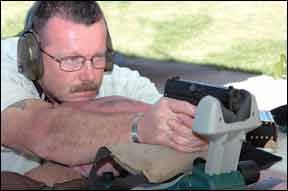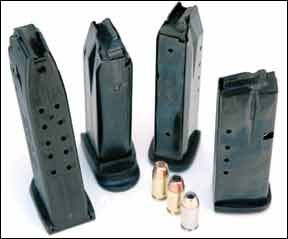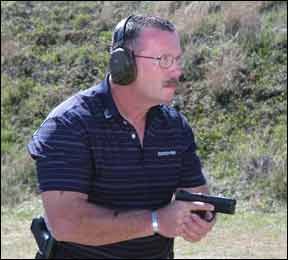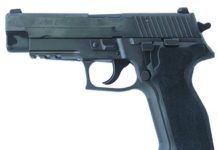In our March 2011 issue we paired small-framed revolvers designed for concealed carry with larger-framed wheelguns in hopes of defining an effective battery of defense for home and street. In this test we’ve taken a similar tack by pairing full-sized 40 S&W pistols with a compact version of each pistol. All four pistols were based on a polymer frame with staggered-column magazines for higher capacity.
Our first pair was from Steyr Arms. They were the new 4-inch-barrel M-A1 pistol and the compact model S-A1 with 3.62-inch barrel. Both guns carry a suggested retail price of $642. These guns were much like the Steyr pistols imported several years ago that performed favorably in a test published in the April 2001 issue. Among the changes to the latest Steyr pistols was a shorter-action trigger.

We matched the Steyr pistols against a pair of Heckler & Koch USP pistols that offered a trigger system unfamiliar to most shooters. Devoid of safety or decocker levers, our $952 USP and $991 USP Compact Variant 8 pistols each utilized a full-time double-action trigger referred to as the LEM, aka Law Enforcement Module.
One significant difference between our comparison of the revolvers and the pistols in this story was that the delineation between house gun and carry gun was not as clear. The bigger revolvers were fitted with long 6-inch barrels for maximum sight radius and greater propulsion of the bullet. Their weight also played a part in recoil control. The small-framed revolvers were built to be as light and as small as possible, with priorities such as recoil control and shooter comfort further down on the list. In the case of the pistols in this story, one might choose a duo of big and small as we intend, but then again the capacity and power of the compact pistols may be enough for use as a primary gun.
In choosing our test guns, we thought we had done a good job of picking two equal teams. But we soon realized that the lack of a Picatinny rail on the Heckler & Koch USP pistols might cause buyers to shy away. To level the playing field, we found a $10 adaptor listed under the Laser Legacy menu on the LaserLyte website. We then purchased one of Laserlyte’s new Subcompact V3 lasers. Smaller than a matchbook and priced at only $99, we could think of no excuse not to have one.
Full-size pistols are often tested for accuracy from the 25-yard line. Most forums test compact pistols from 15 yards. We decided to split the difference and test all four guns from the 20-yard bench. Here is why. We reasoned that what little knowledge of the bigger guns we would gain from the extra 15 feet would be overshadowed by finding out how hard we could push the compact pistols. We wanted to know how much accuracy we were giving up by switching to the compact models. For support, we used the $60 Caldwell Matrix shooting rest from Battenfeld Technologies. We augmented the Matrix with sandbags to support our elbows, forearms, and head. Yes, we even piled sandbags beneath our test shooter’s chin. The guns were easy to stabilize in the Caldwell rest, but we didn’t want the shooter’s eyes shifting as the head bobbed around in the crosswinds. The only thing moving in this set up was the trigger finger.
We did not expect the compact guns to be as accurate as the full-size models. All four pistols had full-length dustcovers, but the smaller guns offered a limited area on which to rest the guns. Another key element was reduced sight radius. We also wondered if the shorter grip of either compact pistol would be a factor.
Test ammunition consisted of Winchester USA 165-grain FMJ target ammunition and two hollowpoint defense rounds. The defense loads were the Remington UMC 180-grain JHP rounds sold in 100-round value packs and a new round from DoubleTap ammunition topped with a 150-gr. Nosler JHP bullet. In addition to our bench rest session, we also performed a rapid-fire action test from the 7-yard line using the 165-grain rounds. The target was an IPSC Metric target offering a rectangle measuring about 5.9 inches by 11 inches in the center and a “head” area measuring about 6.3 inches by 6 inches above. Beginning with the gun in both hands pulled in towards the chest (finger off the trigger), our military/LE tester fired two shots to center mass and one to the head over 10 separate strings of fire. We recorded first shot elapsed time as well as overall elapsed time and looked for a total of 30 hits on target, including 10 shots to the head.
Heckler & Koch USP LEM 40 S&W, $952
Heckler & Koch USP Compact LEM 40 S&W, $991
The HK Universal Self-loading Pistols include several features that indicate it is a fighting pistol first and a target gun second. The oversized trigger guard was meant to accommodate a gloved finger. The indentations found on each side of the magazine well were designed so that if need be, the magazine could be ripped from the receiver. The ambidextrous magazine-release levers were designed to be impervious to accidental discharge. The sides of the grip were flat and thin with stippling on the sides and checkering on the frontstrap and rear surface of the grip. Each of these features was evident on our 4.25-inch-barrel full-size and our 3.58-inch-barrel compact. The bore featured polygonal rifling. The full-size USP arrived with two polymer-bodied 13-round magazines. The compact model came with two steel-bodied 12-round magazines complete with basepads that added a lip for the pinky finger.

What made these two test pistols special was the full-time double-action trigger that does away with the side levers we are used to seeing on the USP models that serve to both decock the action and lock the hammer safely in its rearward position. Nevertheless, both pistols showed a relief as a tell-tale sign that a lever used to be there. The full-size pistol even showed a white line on both sides of the frame that was no longer necessary. These subtle vestiges were evident because the USP design is modular and can accommodate any one of nine different trigger systems. Our pistols operated with the LEM Law Enforcement Module triggers. With the LE module in place, movement of the slide set the hammer away from the firing pin, which was safely blocked from moving forward by impact. Once a round was chambered and the action was cocked, movement of the crescent-shaped trigger consisted of a takeup requiring about 4.5 pounds of pressure. The distance the trigger was pressed corresponded to the distance the hammer traveled rearward to its stopping point. Breaking a shot required about 8.5 pounds of pressure for the full-size USP and only about 7 pounds of pressure for the compact model. The LEM trigger may not be user-adjustable, but the design is ‘smith-able. However, the best results as reported by competitive shooters we’ve met were achieved by Heckler & Koch factory technicians. But even in stock condition, this we thought this was one of the best definitions of double-action-only we’ve tried.
Takedown of both guns was simple and did not require pressing the trigger. We began by shifting the top end rearward until the relief in the slide met with the squared outline directly above the slide-stop pin. From the right side we started the pin outward with finger pressure only and plucked the slide-stop assembly from the left side of the frame. The receiver, or grip frame, of the HK pistols was exceptionally light, 6.8 ounces for the bigger gun and as little as 6.5 ounces for the compact. Transfer bar, hammer assembly, ejector, and a pair of small steel inserts front and rear for slide contact were just about all that was evident once the top end was removed. The HKs do not rely on a locking block to catch the barrel during cycling. Instead, the rear of the guide rod carried two lugs, one on its bottom surface and one above. The lower lug fit over the slide stop pin. The upper lug locked up with the barrel. Both guide rods were steel. The guide rod of the USP Compact was surrounded by a single filament spring with a nylon shock buff that rode independently along the rod. The guide rod on the larger pistol was different. The forward portion of the rod was thinner, and fixed to the rearward part of the rod was a collar and sizable steel roll pin. About 0.7 inches of the rearward portion of the rod featured a captured spring. But the rod itself was not compressible. According to HK, this secondary spring was designed to compress under its own inertia to absorb energy and act as a buffer. Recoil action of the slide was handled by the larger-diameter spring that encompassed the length of the guide rod from its forward tip to the aforementioned lug.
At the range we found it easy to get a clear sight picture from the combat sights that were dovetailed into place front and rear. Both pistols arrived with the same sight package, which featured three white dots. The sturdy rear unit offered sloping sides to bring the shooter’s eyes to the notch that much quicker. In terms of precision, the full-size USP was the top performer in our tests. The Remington UMC ammunition produced the smallest average group size, measuring 1.1 inches across. The 180-grain JHP-topped UMC rounds may be considered a classic 40 S&W round. We might also venture that the USP is a classic pistol, so we were not surprised they worked well together. But special mention has to go to the 150-grain DoubleTap round, which finished second in our accuracy tests but first in providing the most muzzle energy.

From the bench the USP Compact was not as accurate as the bigger gun, but it was more consistent by showing less favoritism between loads. With the exception of a wider spread between smallest and largest groups when firing the 180-grain hollowpoints, numbers were actually quite close. Both Remington and Winchester ammunition produced an average group size measuring about 2.0 inches with both the DoubleTap rounds and the Remington ammunition. The Winchester FMJ rounds recorded an average group size of about 2.2 inches.
The reduction in velocity between the full-size and compact USP models averaged about 47 fps on average, according to our 15-year-old Oehler 35P chronograph (which, by the way, had just been tested at the factory in San Antonio for accuracy, with superb results).
In the rapid-fire action test, our first run with the full-size USP took 2.40 seconds. Thereafter, average elapsed time for the three shots computed to 2.00 seconds. The fastest first shot took about 0.98 seconds from start signal. The target showed all 10 expected hits in the head area and 19 of 20 hits inside the center-mass A-zone. Call it knitpicking, but one bullet hole was literally 0.2 inch to the right of the A-zone. Our shooter’s comment was, “I can fight with this gun.”
The USP Compact felt more maneuverable but provided only slightly quicker times. Average elapsed time was computed to 1.97 seconds. But, there were some very fast times offset by a couple of errors. Final runs were over in as little as 1.64 seconds, where times with the full-size USP leveled off and never really improved. Our shooter reported that the cycling speed of the USP Compact was fast enough to challenge the shooter’s ability to respond to a fresh sight picture. Muzzle flip, although pronounced, was over quickly. The lighter trigger on our compact pistol was also most enjoyable. Hits on our action target showed a more compact group at center mass than was achieved with the bigger USP, with just a couple of hits straying to the edges of the A-zone. Six of ten hits to the upper zone formed a group at its center, with one shot pulled low of the head area.
Our Team Said: Although the full-size Heckler & Koch USP was remarkably accurate, our favorite test gun was the Compact model. A battery of the two pistols proved to be a sure winner, but if we had to choose only one, we think the USP Compact would be our do-everything, go-anywhere choice.
Steyr M-A1 40 S&W, $642
Steyr S-A1 40 S&W, $642
This is the second time that Steyr has imported its polymer pistols. Since it was withdrawn several years ago, Steyr has made a substantial footprint distributing a full line of impressive long guns inside the United States. With corporate presence firmly established it would appear that buyers can feel safe that Steyr’s commitment to the pistol market will follow suit. Our full-size M-A1 and compact S-A1 40 S&W pistols were the first of Steyr’s new handguns, and since this test was planned, 9mm models are also being imported. Although the slide of each gun clearly read M40-A1 and S40-A1 respectively, company reps and the Steyr Arms website uses only M-A1 and S-A1 for designation. The first Steyr pistol we tested (April 2001) was in fact a 9mm, and it utilized a manual safety that was deactivated from inside the trigger guard. This feature is now gone from current production, but much of the original design remains the same.
The Steyr polymer pistols offered a distinctive profile. The fronts of the guns were boxy and flat top to bottom, almost reminiscent of a Taser. The single-lug accessory rail added about 0.33 inches of vertical drop compared to the original Steyr M9 pistol. The blocky profile was undercut at the rear by the grip that offered not only a pronounced palm swell but a rakish angle and deep indention to put the web of the hand as much as 0.9 inch beneath the rear of the slide. In lieu of aftermarket availability, some very handsome $80 leather holsters made specifically for these pistols can be found on the Steyr website.
Steyr continues to equip its pistols with triangular notch and post “trapezoidal” sights dovetailed into place front and rear. The front sight was an equilateral triangle measuring about 0.32 inch with its face almost completely in white. The paint was not self luminous, but it had enough depth to look like frosting. The rear notch outlined the bottom half of the triangle, leaving the top half open. Two white lines ran along the sides of the rear notch. Tritium replacement sights are available from Trijicon, Inc. (#ST01, $115). But these sights are standard 3-dot configuration.
The takedown latch was integrated with a lockout safety system. By inserting one of the two supplied keys, the firing system can be stalled. This also prevented the guns from being disassembled. For field stripping, we needed to press the trigger, push in the spring-loaded keypad and rotate the disassembly latch downward. The top end was then eager to slide from the frame. Reassembly was achieved simply by replacing the slide. Both pistols operated with a captured single-filament flat-wound recoil spring and shared the same operating system. The slide rode on a set of steel rails inlaid into the polymer frame. The barrel cycled in and out of battery by making contact with a locking block at the center of the frame. Movement of the slide set the firing pin spring. According to the manufacturer, the trigger did not contribute to final compression of the firing-pin spring. Steyr counts movement of the slide and release of the firing pin by the trigger as the two ingredients of double action. We’re not sure we agree with this definition, but in our view it makes for a very good trigger.
Both pistols arrived with two steel-bodied magazines. The M-A1 utilized a 12-round magazine and the S-A1 magazine held 10 rounds.
Most noteworthy of the changes from the original M-series pistol was the trigger. With a safety-release lever in the face of the trigger, the overall action was noticeably shorter. Takeup consisted primarily of the distance it took to press in the safety. This required a mere 2.75 pounds, according to our Chatillon recording trigger gauge. Complete ignition required about 8.5 pounds for the S-A1 and about 7.5 pounds for the M-A1 model.
Our test shooters thought the trigger was precise. But the smallest average group size we were able to achieve, 1.7 inches, was with the M-A1 firing the Remington UMC 180-grain hollowpoints. Group sizes were larger and less consistent compared to the same ammunition fired from the full-size USP. Simply put, we found the sights difficult to work with in a slow-fire controlled-press format at a distant target. While some of our initial shots were accurate, our eyes soon tired of trying to decipher an exact point of aim from the triangular notch and post. The good news was that there was not as much drop off between the full-size and compact models. In fact, accuracy firing the DoubleTap ammunition was almost identical. This was because there was very little difference in barrel length and sight radius between the two guns. In fact, the compact S-A1 fired from a barrel that we measured to be 3.64 inches in length from barrel crown to chamber mouth. The M-A1 barrel was little more than about 0.20 inches longer. Evidently, the Steyr interpretation of “compact” and “full size” was limited to reducing the grip length for less print when seated in a belt holster rather than an overall reduction in size. The difference in velocity produced by the slightly longer barrel (as much as 44 fps firing the DoubleTap ammunition) was not solely the product of increased barrel length, in our view. We think a difference in individual chamber size could also have played a part.
During our bench session we discovered that the smaller S-A1 pistol had difficulty returning to battery. Several times the slide was not able to move fully forward to lockup with the trigger, failing to ignite the round. This occurred primarily with the Winchester USA 165-grain FMJ ammunition, which was less powerful than our other test rounds. But the problem was evident when simply hand cycling the gun as well. We felt that the S-A1 needed a stronger recoil spring. Despite the minimal difference in barrel and slide length, the recoil spring assemblies were not interchangeable. In fact, the guide rod and spring from the M-A1 was longer and noticeably heavier in construction. The best way to avoid stoppages of this type, we found, was to shoot heavier-recoiling ammunition. In fact, we had to resort to using the 180-grain JHP rounds in our action test to run the gun reliably. Another problem we encountered was that the S-A1 shot consistently to the right of aim from the bench. We weren’t able to substantiate a mechanical problem with the pistol, but suspect it was a byproduct of eye fatigue brought on by trying to work with the triangular sights. The reduced grip area also prompted our shooter to overcompensate with a heavier grip that was not conducive to fine accuracy.
Results from our action tests showed that the triangular sights could be an advantage at short distances. The S-A1 compact pistol helped our shooter to an average elapsed time of 1.74 seconds. First shots averaged about 0.85 seconds from the start signal. Encouraged to push faster and faster, we did manage to push a third shot above and off the paper. Otherwise, we also put two shots low of the upper A-zone and two more shots to the right of the center mass A-zone. Our shooter said that the fast action was there, but it was possible to overrun his ability to follow the sights.
Our notes from our action session with M-A1 read, “Great trigger, not for the novice.” Our first run took 2.28 seconds to complete after a 1.04-second first shot. By string number six, our elapsed times had dropped to 1.51 seconds. This was followed by runs taking 1.32 and 1.37 seconds respectively. First shots in less than 0.80 seconds after the start signal became the norm. In terms of accuracy, the upper portion of the target showed nine hits with one shot low. Three shots had been pushed to the left of the center A-zone.
Our Team Said: Regardless of the faster elapsed times at close quarters, our staff would change out the sights on both guns to just about anything plainer and simpler. The preferred pistol in this duo was the larger M-A1. The larger grip was not so long as to be obtrusive for carry, and the gun simply ran more reliably and inspired more confidence. Rather than pair these guns as battery mates, we might like to see a smaller S-series pistol or a larger M-series gun to better delineate their individual purposes.
0611-40-SW-PISTOLS-ACC-AND-CHRONO.pdf
0611-HECKLER-KOCH-USP-40-LEM.pdf
0611-HECK-KOCH-COMPACT-40-SW.pdf


























